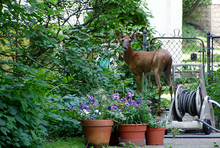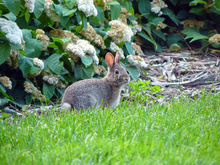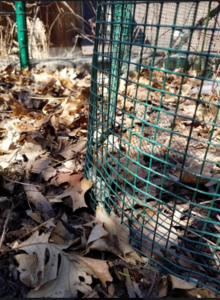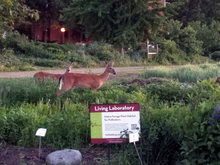Winter is a difficult time for wildlife. The cold and snow are challenging and food is scarce. Wildlife habitat is constantly being altered and infringed upon by housing developments, infrastructure and lack of natural predators, and affected by climate change, human activity and pollution. This can make even the most skittish animal turn to alternative food and habitat sources — including our home landscapes.
Animal damage in the landscape
Mice, rabbits, voles and deer feed on twigs, bark, leaves and stems in winter. Animals may girdle trees and shrubs by chewing through bark. They may also feed on shrubs, cutting them to the ground. The best overall strategy is to use a combination of physical barriers and reduced nesting habitat.
Deer
Deer spend a majority of their life feeding. They will eat anything if they are hungry, even plants labeled as "deer resistant." And fawns will try any plant once.
Deer like lush, green plants; exactly the kind we grow in our gardens and home landscapes. They feed on buds, stems, side branches, fruits and flowers of small trees and shrubs. They may also damage tree bark by rubbing and scraping their antlers and foreheads on tree trunks in late summer and early fall to remove the “velvet” from their new antlers.
The Minnesota Department of Natural Resources (MN DNR) considers deer a protected game species.
Rabbits
While deer are challenged by deep snow, rabbits benefit from it. Being lightweight, rabbits can sit on top of snow drifts and feed on twigs and buds. They can also feed on plant stems, sometimes girdling the branches. "Girdling" is the act of eating through the bark and cambium layer of woody stems and trunks. The cambium layer is located just underneath the bark and is the active growing layer of a tree or shrub. Rabbits are small, swift and easily hidden.
According to the MN DNR, rabbits that are causing damage may be taken by landowners. Find out more about dealing with rabbits on the DNR website.
Other rodents
Smaller rodents like mice and voles can also damage plants by feeding on thin-barked trees and shrubs. They burrow under snow and through protective plant material left long around shrubs and trees. Their trails can sometimes be seen like raised trails through the snow.
Add physical barriers around plants
The best way to exclude animals and prevent browsing is to set up barriers around plants. They should be installed in the fall before snowfall and can be left in place during the growing season or removed.
Rabbit, mice and vole fencing
- Protect trees and shrubs in winter from girdling.
- Minimum 4 feet tall to accommodate the average snowfall depths.
- Hardware cloth (¼-inch square openings).
- Bury the bottom edge of fencing a few inches in the soil to prevent animals from burrowing under the fencing.
- Anchor the fencing with landscape staples, tent stakes or poles.
Deer fencing
- Protect trees and shrubs in winter from browsing on twigs and buds, and damage to trunks from rubbing and scraping.
- White plastic tree guards protect bark from rubbing (and sunscald).
- Minimum 8 feet tall; deer can clear fences as high as 12 feet.
- Well-constructed fencing as deer may break down or jump over weak fencing.
- Electric cattle fencing
- Micro-enclosures
- How to manage deer damage on trees and other plants
Bud capping
Another type of barrier designed to specifically protect young evergreens from deer damage is bud capping. Deer will eat the young buds of trees including pines and other evergreens, stunting their growth and misshaping the plant form.
Bud caps are simply 4x5-inch pieces of plain bond paper folded and stapled over the terminal bud of a young evergreen in the fall. Watch this bud capping demonstration video.
Reduce shelter and nesting habitat in the landscape
Animal habitat is being reduced by housing developments, infrastructure and expanding cities. So it makes sense they will seek shelter and nesting habitat anywhere they can find it, including home landscapes.
Animals can find shelter under decks, behind barriers, in dense thickets or behind woodpiles. Nesting habitat can be in leaf piles or piles of brush left in a protected back corner of your property.
To reduce animals from taking up residence on your property:
- Eliminate protective cover.
- Burn or haul away tree and shrub branches after pruning.
- Fence leaf piles for composting or spread leaves as mulch around your plants.
- Fence off areas that offer protection such as under decks using hardware cloth or cedar lattice.
- Cut down and remove vegetation in late fall within 2 feet of young trees.
- Reduces protective cover for mice and voles that might feed on trunks and stems.
- Reduces potential for snow mold on lawns and grasses.
Use repellents to deter animals
Repellents are not poisons. They deter animals from feeding because of their smell or taste. Repellents may be a more economical solution to fencing. You can spray or paint them on trees and shrubs and one application is usually enough for the entire dormant (winter) season.
To repel animals during the growing season:
- Apply repellents early in the growing season to train animals not to feed on your plants.
- Apply repellents after rain and irrigation.
- Rotate and change repellents throughout the growing season. Animals like deer can get used to a repellent, making it ineffective.
- Some repellents are systemic meaning they are taken up by the plant through its roots to make the entire plant taste bad.
- Find out more about deer repellents.
Protecting trees and shrubs in winter - U of MN Extension
How to protect trees and shrubs from animal damage over winter – Iowa State University
Preparing trees for winter – North Dakota State University





